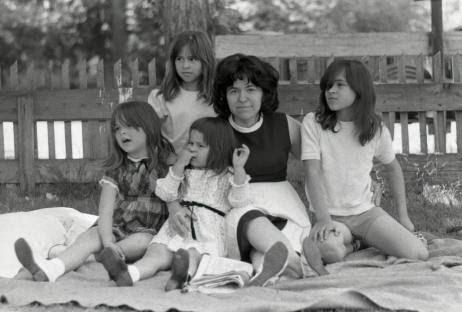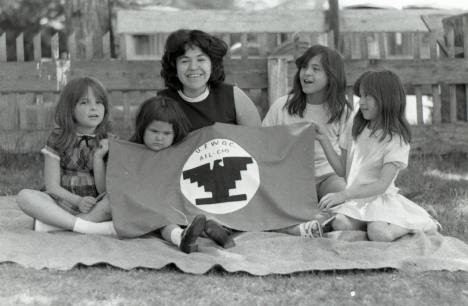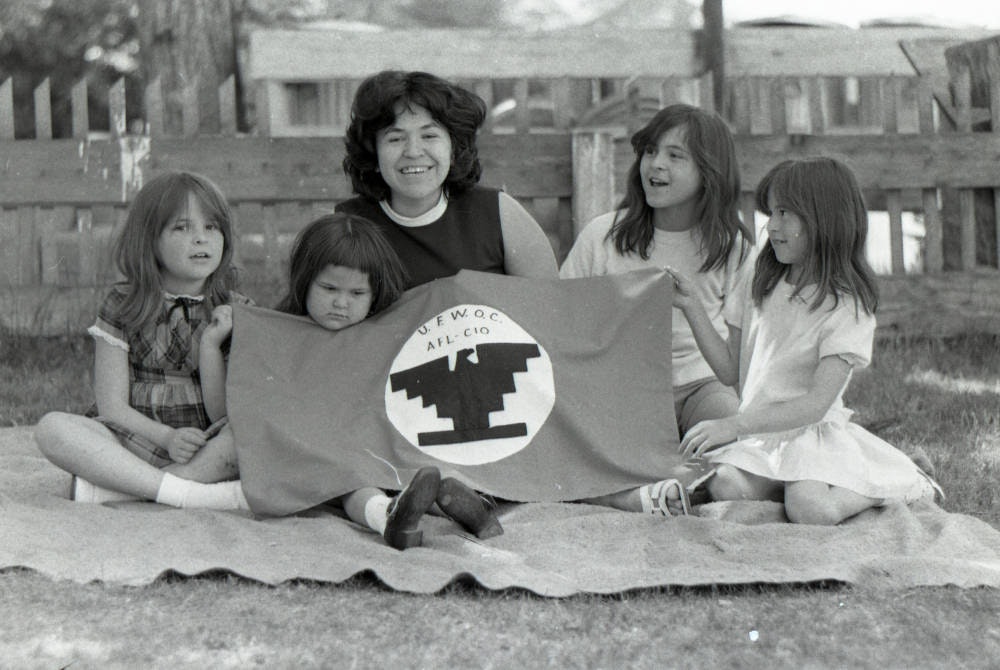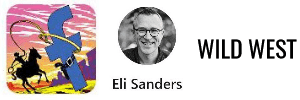In the archive, she was catalogued as “Woman standing on porch.” But she had a name, and it surfaced last month in an unusual Facebook group devoted to adding life to thousands of still images sitting in a scarcely known collection in rural Washington State. Most of the images being examined by the Facebook group are nearly 50 years old, taken by Seattle photographer Irwin Nash after he set out to chronicle the experience of Latino farmworkers in the Yakima Valley during a pivotal period in their struggle for greater rights.
The Facebook group’s small clan of idealistic detectives, amateur oral historians, and thrilled descendants of farmworkers offers quite a contrast to the usual news coming out of Facebook’s much-criticized “groups” feature in recent years. Once touted by Mark Zuckerberg as a way to “strengthen the social fabric,” Facebook groups have instead been used to spread hate, promote dangerous falsehoods, drive radicalization, and hatch destructive plots like the one aimed at kidnapping Michigan Governor Gretchen Whitmer. According to an internal Facebook report, groups on the platform also “helped incite the Capitol insurrection.” And according to researchers, Facebook’s algorithm for nudging people into groups has for years pushed users toward extreme content. That problem apparently led Facebook to temporarily shut off its group recommendation engine in the weeks before the last presidential election, a step that unfortunately wasn’t enough.
Then there’s the Nash Photo Collection Facebook group, where beautiful tributes and names keep coming in for the individuals in the long-forgotten photographs. If the primary words Facebook’s critics associate with its groups right now are “polarization,” “misinformation,” and “violence,” here is a relatively unknown Facebook group dedicated to producing their opposites, adding new layers of rich humanity and personal truth to a topic long viewed through lenses clouded by racism, acrimony, and misunderstanding. As the group’s members work, they’re also building awareness of an obscure archive that, for most of its life, has been loved mainly by archivists.
The Facebook group was created in April after the archive of around 9,300 photographs, all housed at Washington State University in Pullman, south of Spokane, received a sudden push toward full digitization.
Dr. Lipi Turner-Rahman, the manager of the university’s Kimble Digitization Center, had been thinking for a while that the Nash collection could be destined for something bigger. She’d heard of an $8,000 grant being offered by the Washington State Libraries to fund a worthy digitization project and had begun looking through WSU’s various special collections, wondering which one of them might make a the best candidate.
Then COVID hit and she had a lot more time to think. She decided the Nash collection was the one because it contained “a nice, finite number” of images to digitize, and also because the grant was intended to benefit the people of Washington State. WSU is a land-grant institution, Dr. Turner-Rahman explained, “and our purview is to make lives better for the citizens of Washington.” She believed this digitization project could “help the Yakima valley community reevaluate their sense of themselves and their history.”
Last fall she got the grant and suddenly, after decades of having to limit access to the collection, Dr. Turner-Rahman could see a clear path to digitizing the entire Nash archive by the middle of this year. That milestone will allow all the photos to be placed online, where anyone with an internet connection can view them.
But Dr. Turner-Rahman decided she shouldn’t stop there.
“I felt, as a person of color myself, that we couldn’t really just stop with digitizing the material,” Dr. Turner-Rahman said. “That it was really important to have names of the people and stories of the people in the photographs, because it really is about putting their counter-stories out there. Because there is a narrative in the US about, you know, that this is a white country and people came, they made it great, this stuff. And we tend not to look at other communities and their achievements, what they gave to the story. And that’s what I’m looking for. In my work, I want to showcase that—those counter-stories of people who get ignored.”
She thought about using Facebook to solicit the counter-stories. She also thought about sending people into the Yakima Valley community to collect in-person oral histories from those whose memories might enhance the public’s understanding of moments captured in Nash’s photographs. But for the time being, these were only thoughts.

“This is my Uncle Vicente Castro,” wrote a member of the Facebook group about the above image / Courtesy Irwin Nash Collection, Washington State University Libraries Manuscripts, Archives, & Special Collections
In March, having caught wind of the digitization grant, Sandeep Kaushik, a political consultant and former full-time journalist, wrote a longform article exploring the “nearly forgotten” Nash archive, and the window the archive now offers onto what one activist called “the awakening of a people.”
In a reminder of how fragmented the media environment has become, it wasn’t until the Yakima Herald newspaper picked up the ball and ran a front-page feature showing a number of Nash collection photographs that Dr. Turner-Rahman really began hearing from people in the Yakima Valley. They knew the individuals in those images. They wanted to share their stories.
In its way, the Yakima Valley reaction was also a reminder that old media still does some things better than new media. The Yakima Herald published its article on April 18, in “a medium that a large portion of that community are reading,” Dr. Turner-Rahman noted, and “that morning I had people email me: ‘This is my sister. This is my brother.’”
It was this experience that pushed her to forge ahead with the idea of a Facebook group, which she’d been discussing with Seattle attorney Laura Solis and her partner Mike Fong. Solis grew up among farmworkers in the Yakima Valley and had been working in recent years on an ancestry project. While doing research for this project, Fong and Solis had stumbled upon the Nash collection.
By Facebook standards, the Nash Photo Collection group, with just under 300 members, is not large. But by Facebook standards it seems exceptionally inspiring. In April, a loving tribute shared with the group provided a name for the “Woman standing on porch.” The tribute came from a person who identified himself as her son.
Likely because of moments like this, the group is growing. With this increasing scale come familiar and challenging questions about the potential downsides to the vast reach and immediate impulse gratification Facebook offers its users.
“When I started the Facebook group, I was a little nervous, I will not lie,” Dr. Turner-Rahman said. She’s well aware of how Facebook groups have been used for ill in recent years. Solis, too, worries the group could grow large enough to attract the kind of people who dedicate significant amounts of their time to befouling the internet: trolls, mean-spirited meddlers, anti-immigrant racists. That’s been the arc of countless online endeavors that, like the Facebook groups idea itself, began by showing fantastic promise for enriching the human experience but ended up being overtaken by digital waves of contempt, scorn, dehumanization, lying, deranged attention-seeking, and all sorts of other destructive impulses that seem to be emboldened in the virtual realm.
Some of the Nash photos themselves, Solis noted, document tension between the white power structure in the Yakima Valley and activist farmworkers. “It’s not like that tension has necessarily gone away over the last 50 years,” she said. “It’s something you sense in the community today. I think that potentially it’s a powder keg.”
But for now, Dr. Turner-Rahman and Solis are amazed by what’s happened in the group up to this point. Neither of them can think of anything quite like it. The Nash Photo Collection Facebook group is a crowd-sourced historical excavation. It’s an ad hoc narrative reclamation. It’s an exercise in making and deepening intergenerational connections. It’s mystery-solving done digitally. It’s just plain exciting. And the tone of the discourse, so far, has one of respect, awe, and celebration.
To protect this great vibe, the group is open only to people who are either invited or ask to be let in and are willing to answer one or two straightforward questions.

Boy harvesting asparagus / Courtesy Irwin Nash Collection, Washington State University Libraries Manuscripts, Archives, & Special Collections
“Facebook is just another tool,” Dr. Turner-Rahman explained. Because of its massive scale and well-developed tagging, photo-sharing, and commenting features, it happens to be a perfect tool for this project. But it’s not the only useful tool for gathering names and oral histories that fill out the stories the Nash photographs begin to tell. People still call and email Dr. Turner-Rahman directly with new information, and those people tend to be older than the ones engaged in the Facebook group.
At the moment, Dr. Turner-Rahman feels comfortable with the veracity of the facts being surfaced by the group because it still has a manageable number of members, allowing her to see familial connections between people and get a sense of how each person would know what they claim to know. “But if I opened it up to the whole wide world, it would be a totally different kettle of fish,” she said. “I think it works if it’s in a small environment. I think scale is the issue.”
To Solis, another thing going for the Nash Photo Collection Facebook group is that it’s a virtual project tied to a distinct physical space, the Yakima Valley. “Yeah, it’s online, and it’s virtual, but you know these folks,” she said. “Or you know people who know them, and they’re related to you. And I think that may help… It’s their families. It’s their lives.”
In a way, the rare and wonderful dynamic in this Facebook group supports an idea floated at a recent US Senate hearing on how digital platforms are shaping public discussion and individual minds. Dr. Joan Donovan of Harvard’s John F. Kennedy School of Government used the hearing to call on the US government to give digital platforms new “public interest obligations.” As Dr. Donovan explained it, such obligations would force companies like Facebook to “curate timely, local, relevant, and accurate information.” In other words, a government mandated, all-of-company effort to essentially encourage the positive atmosphere, fact-finding orientation, and local focus of the Nash Photo Collection group across the rest of Facebook.

Children at a daycare center in Toppenish, Washington in 1972 / Courtesy Irwin Nash Collection, Washington State University Libraries Manuscripts, Archives, & Special Collections
For his article at Post Alley, Kaushik ended up tracking down Irwin Nash. Initially, he’d assumed the photographer was dead but in fact he is very much alive, “84 years old and… currently living in an assisted living facility in Seattle,” as Kaushik reported.
Nash “grew up in Seattle’s Central District, the son of Jewish immigrants from Poland who emigrated in the 1920s hoping both to escape anti-Semitism and to improve their economic circumstances,” Kaushik wrote. “His upbringing in Seattle led to his burgeoning political activism and concern for the plight of the downtrodden, which eventually took him to the Yakima Valley’s agricultural fields in 1967 and kept bringing him back through the mid-70s.”
Of the work he did there, Nash told Kaushik: “This was a labor of love. It needed to be done.”

Courtesy Irwin Nash Collection, Washington State University Libraries Manuscripts, Archives, & Special Collections
Newly digitized images are now being regularly added to the online archive of Nash collection photographs. That, in turn, feeds progress in the Facebook group. Recently, Dr. Turner-Rahman shared a post with the group showing a digitized image of a family sitting on a blanket in a grassy field. “I love this photo of a young family,” she wrote. “I would love to give names to all the members of this family. Let us know if you know them.”
In the comments, someone noted that there is another photo in the Nash collection of this same family, apparently in the same field and on the same blanket, holding a United Farmworkers Flag. “That might imply something more active,” the person wrote, posting the second image.

Courtesy Irwin Nash Collection, Washington State University Libraries Manuscripts, Archives, & Special Collections
“Good catch!” Dr. Turner-Rahman responded.
The next comment came from Angela Ann Treviño: “Oh my goodness!! That’s me and my mom [and] sisters.”
“Which one are you?” Dr. Turner-Rahman commented back.
Treviño, who now has the image with the UFW flag set as her Facebook picture, replied: “I am on the left holding corner of flag..looking at my mom…I remember this day. I miss my mom ..she was my hero !!”
This story first ran on Eli Sanders’ Substack newsletter Wild West. Go here to subscribe
Discover more from Post Alley
Subscribe to get the latest posts sent to your email.


Great piece. What’s happening right now at the Nash Facebook group is truly remarkable and noteworthy.